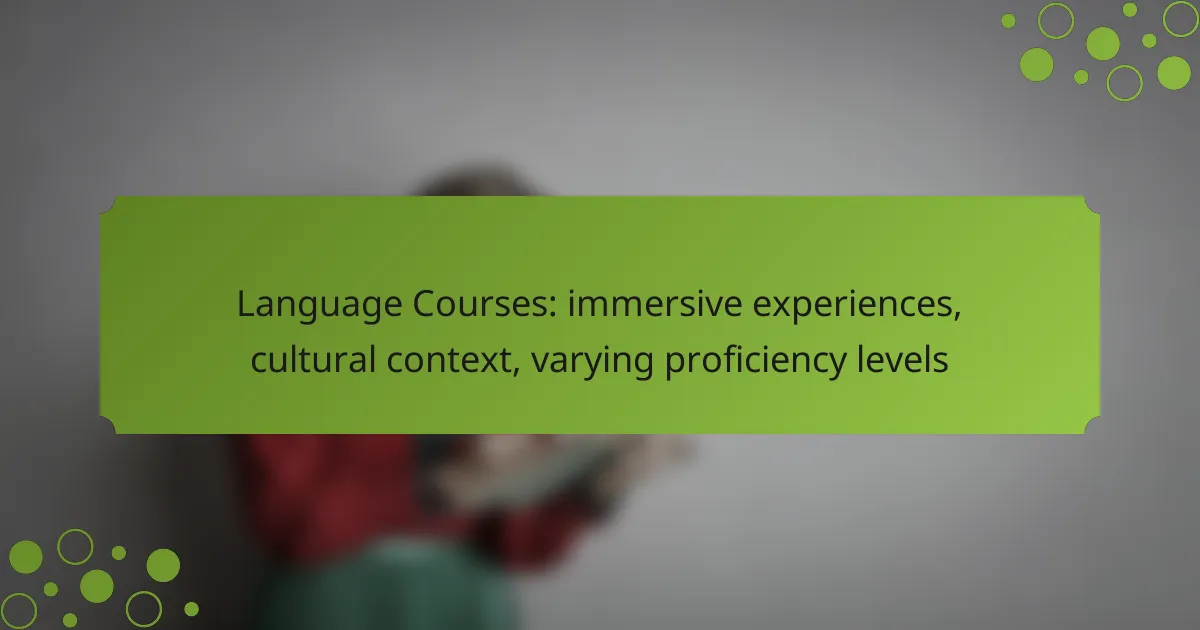
Online language courses that focus on immersive experiences offer a unique blend of interactive learning and cultural context, significantly enhancing the language acquisition process. By incorporating real-life scenarios and multimedia resources, these programs engage learners at varying proficiency levels—beginner, intermediate, and advanced—ensuring that each individual receives tailored instruction to meet their specific needs and goals.
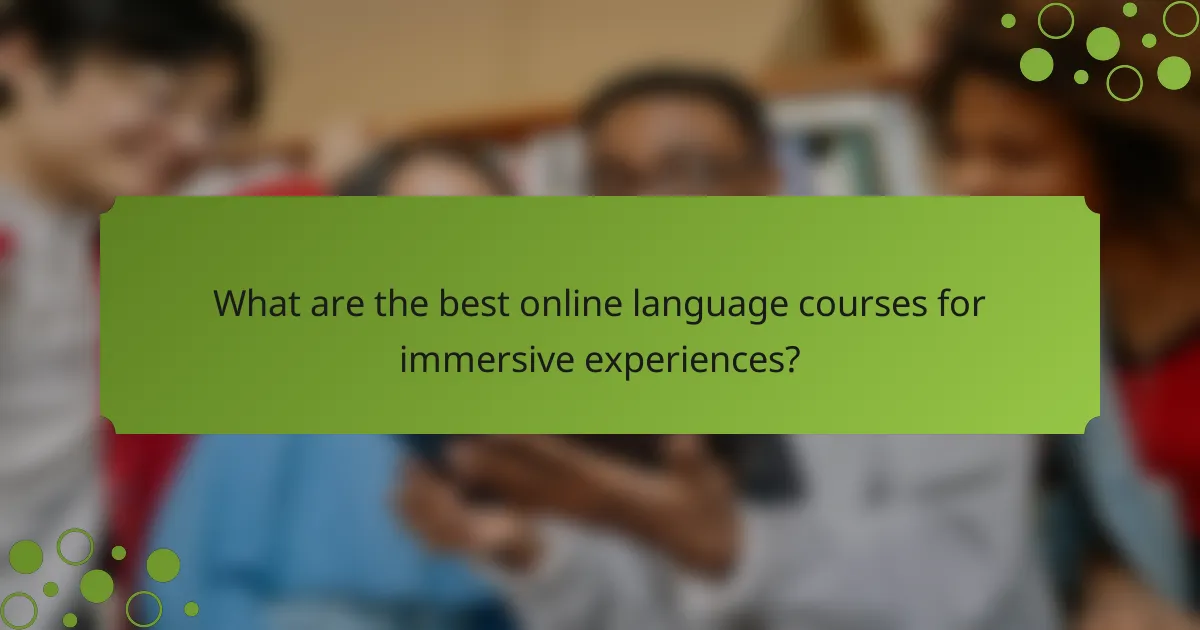
What are the best online language courses for immersive experiences?
The best online language courses for immersive experiences combine interactive learning with cultural context to enhance language acquisition. These programs often utilize real-life scenarios, multimedia resources, and personalized instruction to engage learners effectively.
Rosetta Stone immersive programs
Rosetta Stone offers immersive programs that focus on speaking and listening skills through a dynamic, interactive platform. The courses use voice recognition technology to help learners practice pronunciation in a realistic context, making it easier to develop conversational skills.
Consider the subscription model, which typically ranges from monthly to yearly plans, allowing flexibility based on your learning pace. The immersive approach emphasizes context over translation, helping learners think directly in the target language.
Babbel cultural context integration
Babbel integrates cultural context into its language courses, providing lessons that reflect real-life situations and cultural nuances. Each course is designed by linguistic experts and includes dialogues that mimic everyday conversations, enhancing comprehension and retention.
Babbel’s subscription options vary from a monthly fee to discounts for longer commitments. This platform is particularly effective for beginners who want to grasp not just the language but also the cultural aspects that influence communication.
FluentU video-based learning
FluentU utilizes real-world videos, such as movie trailers and music videos, to create an engaging language learning experience. This method allows learners to see and hear the language in context, which aids in understanding idiomatic expressions and cultural references.
The platform offers a range of proficiency levels, making it suitable for learners from beginners to advanced. Subscriptions are available on a monthly or annual basis, providing flexibility for users to learn at their own pace.
italki personalized tutoring
italki connects learners with native-speaking tutors for personalized language lessons tailored to individual needs. This one-on-one approach allows for immediate feedback and customized learning plans, making it ideal for those seeking to improve specific skills or prepare for real-life conversations.
Pricing varies based on tutor rates, which can range widely depending on experience and location. This platform is particularly beneficial for learners who thrive on direct interaction and personalized guidance in their language journey.

How do cultural contexts enhance language learning?
Cultural contexts significantly enhance language learning by providing learners with real-life scenarios that deepen their understanding of language use. Immersive experiences allow students to grasp nuances, idiomatic expressions, and social norms that are integral to effective communication.
Real-world cultural immersion
Real-world cultural immersion involves engaging with the culture where the language is spoken, which can take place through travel, study abroad programs, or local cultural events. This exposure helps learners to not only practice the language but also to experience the customs, traditions, and daily life of native speakers.
For example, participating in local festivals or culinary classes can offer insights into cultural values and social interactions, making language learning more relevant and enjoyable. Such experiences can lead to quicker language acquisition and a more profound appreciation for the language itself.
Understanding idiomatic expressions
Idiomatic expressions are phrases that have meanings not directly derived from the individual words. Understanding these expressions is crucial for fluency, as they often reflect cultural references and social contexts. For instance, the English phrase “kick the bucket” means to die, which may not be intuitive for non-native speakers.
Learning idioms through cultural contexts, such as watching local films or reading literature, can help learners grasp these expressions more naturally. Engaging with native speakers can also provide opportunities to hear idioms in context, enhancing retention and comprehension.
Engagement with native speakers
Engaging with native speakers is one of the most effective ways to enhance language learning. Conversations with locals can provide immediate feedback, helping learners to correct pronunciation and usage in real-time. This interaction fosters a deeper understanding of language subtleties and cultural references.
Language exchange programs, conversation clubs, or online platforms can facilitate these interactions. It’s important to approach these engagements with an open mind and a willingness to make mistakes, as this is a natural part of the learning process. Avoiding overly formal settings can make conversations feel more relaxed and authentic.
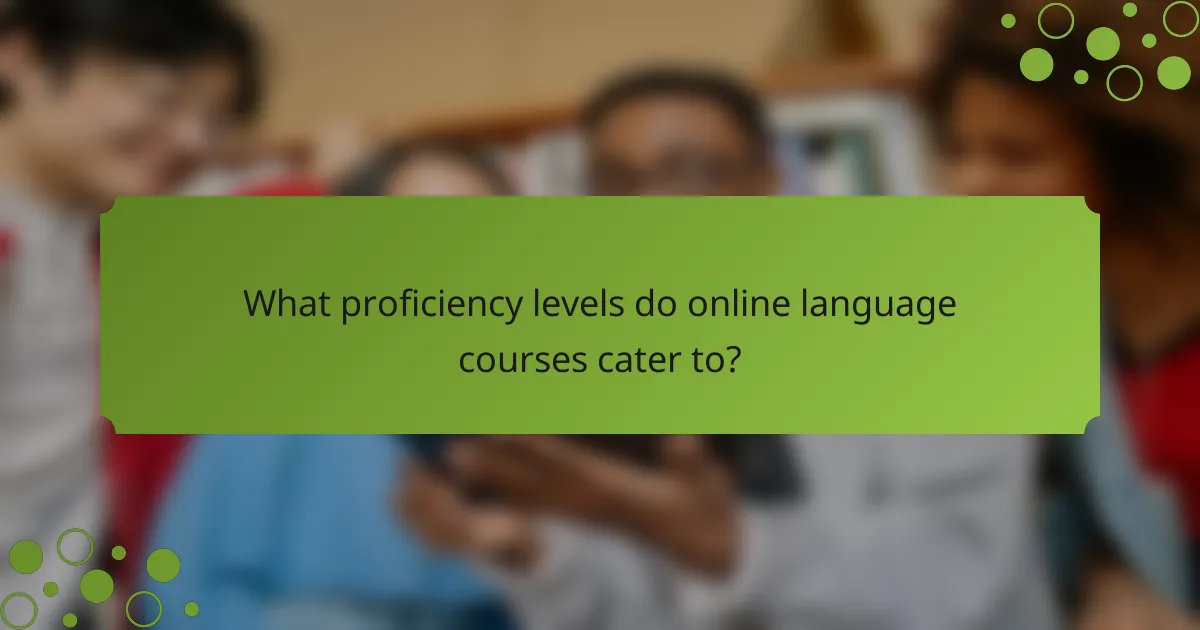
What proficiency levels do online language courses cater to?
Online language courses typically cater to three main proficiency levels: beginner, intermediate, and advanced. Each level is designed to meet the specific needs and goals of learners, providing tailored content that helps them progress effectively.
Beginner courses for foundational skills
Beginner courses focus on building essential language skills, such as basic vocabulary, pronunciation, and grammar. These courses often introduce learners to everyday phrases and simple sentence structures, enabling them to communicate in basic situations.
Many platforms offer interactive activities, such as quizzes and speaking exercises, to reinforce learning. Look for courses that include audio and visual aids to enhance understanding and retention.
Intermediate courses for conversational fluency
Intermediate courses aim to develop conversational fluency by expanding vocabulary and improving comprehension. Learners engage with more complex topics, allowing them to participate in discussions and express opinions on various subjects.
These courses often incorporate real-life scenarios and cultural context, making learning more relevant. Consider courses that offer opportunities for speaking practice with native speakers or immersive experiences to enhance fluency.
Advanced courses for professional use
Advanced courses are designed for learners who wish to use the language in professional settings. These courses focus on specialized vocabulary, advanced grammar, and nuanced communication skills, preparing students for business interactions or academic pursuits.
Look for programs that provide case studies, industry-specific terminology, and opportunities for networking with professionals in the field. Engaging in discussions and presentations can further enhance proficiency at this level.
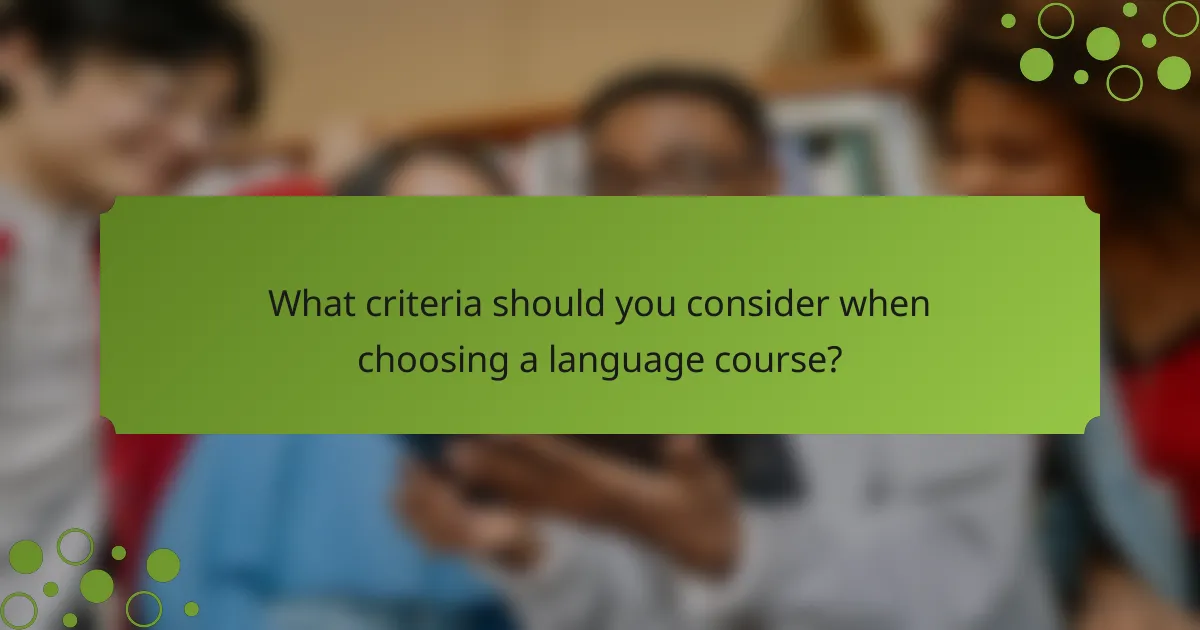
What criteria should you consider when choosing a language course?
When selecting a language course, consider factors such as course content, instructor qualifications, and student feedback. These elements significantly influence the effectiveness and relevance of your learning experience.
Course content relevance
Ensure the course content aligns with your language learning goals and interests. Look for programs that offer immersive experiences, cultural context, and materials suited to your proficiency level, whether beginner or advanced.
For example, if you’re interested in conversational skills, choose a course that emphasizes speaking and listening practice. Courses that integrate cultural elements can enhance your understanding and appreciation of the language.
Instructor qualifications
Evaluate the qualifications and experience of the instructors. Ideally, they should be native speakers or have extensive experience in teaching the language. Check if they hold relevant certifications or degrees in language education.
Instructors with a strong background in linguistics or cultural studies can provide deeper insights, making the learning experience more enriching. Look for courses that offer opportunities for direct interaction with instructors to enhance your learning.
Student reviews and success rates
Research student reviews and success rates to gauge the effectiveness of the course. Look for testimonials that highlight specific outcomes, such as improved fluency or successful exam results.
Consider platforms that aggregate reviews and provide ratings. A course with a high percentage of positive feedback and successful alumni can indicate a reliable choice for your language learning journey.

How do online language courses compare in pricing?
Online language courses vary significantly in pricing based on their structure and offerings. Subscription models, one-time payments, and free resources each present different financial commitments and value propositions for learners.
Subscription models of Duolingo
Duolingo operates on a subscription model known as Duolingo Plus, which typically costs around $6 to $12 per month, depending on the plan selected. This subscription provides an ad-free experience, offline access, and additional features to enhance learning.
While the free version of Duolingo is widely used, the subscription can be beneficial for those who want to accelerate their learning without interruptions. Users should consider how often they plan to use the app to determine if the subscription is worth the investment.
One-time payment options of Pimsleur
Pimsleur offers a one-time payment option for its language courses, with prices generally ranging from $150 to $400 for complete programs. This model allows learners to access all course materials without ongoing fees.
One-time payments can be appealing for those who prefer a clear upfront cost without recurring charges. However, potential users should evaluate the total cost against their learning goals and how long they intend to use the program.
Free resources available on Memrise
Memrise provides a variety of free resources, including user-generated courses and basic vocabulary lessons. While there is a premium version available, many learners can effectively use the free offerings to build foundational language skills.
Utilizing Memrise’s free resources can be a great way to supplement other paid courses or to explore a new language without financial commitment. Users should take advantage of community features and interactive elements to maximize their learning experience.
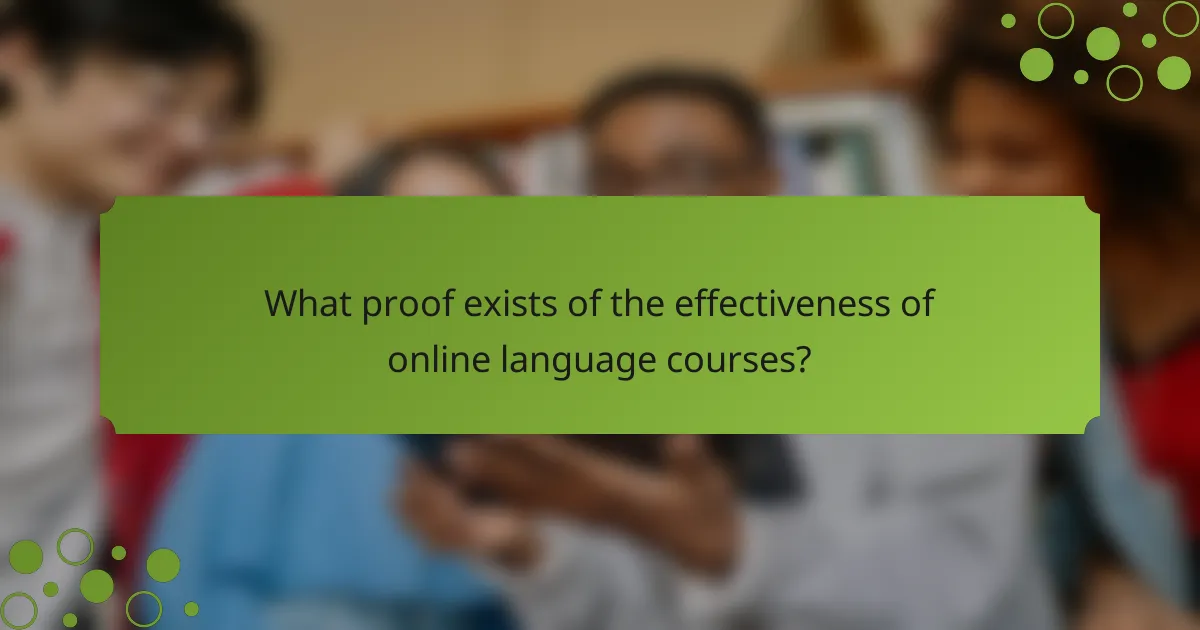
What proof exists of the effectiveness of online language courses?
Research indicates that online language courses can be highly effective, particularly when they incorporate interactive elements and immersive experiences. Many learners report significant improvements in proficiency and confidence when engaging with these digital platforms.
Immersive experiences in language learning
Immersive experiences in online language courses often involve interactive activities, real-life simulations, and cultural exchanges. These methods help learners practice language skills in context, enhancing retention and understanding.
For example, platforms that offer virtual reality environments or live conversation sessions with native speakers can significantly boost engagement. Learners can expect to see improved speaking and listening skills when they participate in such immersive activities.
Cultural context in language courses
Integrating cultural context into language courses enriches the learning experience and promotes deeper understanding. Courses that include cultural lessons, local customs, and relevant idioms help learners grasp the nuances of the language.
For instance, a course focusing on Spanish might include lessons on regional festivals or culinary traditions, allowing students to connect language with culture. This approach not only aids comprehension but also fosters appreciation for the language’s heritage.
Varying proficiency levels in online courses
Online language courses cater to varying proficiency levels, from beginners to advanced speakers. This flexibility allows learners to choose courses that match their current skills and goals, ensuring a more personalized learning experience.
Many platforms offer placement tests to assess proficiency and recommend appropriate courses. Additionally, learners can often progress at their own pace, revisiting challenging topics as needed, which is particularly beneficial for those balancing studies with work or other commitments.


